Mattress Construction
April 2023Mattress Types Explained: how to choose your next bed
Updated 2023: When it comes to buying a mattress, there seems to be a limitless choice of models, materials, spring counts, mattress covers, fibres, gels, foams and the like. We often hear from people that the more they try and research in showrooms and online, the more confused they get when buying a new bed!

This is because most mattress retailers will hideaway key information. Details that, if available, may make you think twice about buying their mattresses. We’re going to give you all these hidden mattress details to make sure you choose the absolute best mattress for your budget and sleeping requirements.
This article will help explain the basics so you know exactly what type of mattress will suit your sleeping requirements. Cutting down on showroom visits and saving you from making a potentially expensive mattress mistake! (All price guides are based on a Kingsize mattress model)
Different Mattress Types Explained
There are 5 different types of mattress you will be researching when buying a new bed. In order of quality and variety we have the open coil, memory foam bed, hybrid foam mattresses, latex mattresses and lastly the most adaptable the pocket sprung mattress.
Let’s delve a little deeper into these mattress types.
- Open Coil / Traditional Bonnell Spring Mattress
- Memory Foam / Mattress in a box Mattress
- Hybrid Foam Mattresses
- Latex Foam Mattresses
- Pocket Spring Mattresses
- Mattress types to avoid at all costs
1. Open Coil or Traditional Spring Mattresses
We’re going to start with the very cheapest mattress construction method the open coil.
If you’re paying less than £300 for a mattress then the chances are the spring unit will be the cheapest spring unit possible. The Open Coil or Cage Sprung mattress. These are made for the very specific cheap entry-level mattress market. They may also go by the name Bonnell coils, Offset coils, Continuous wire coil, Miracoil, Posturetech, Traditional Coil etc.
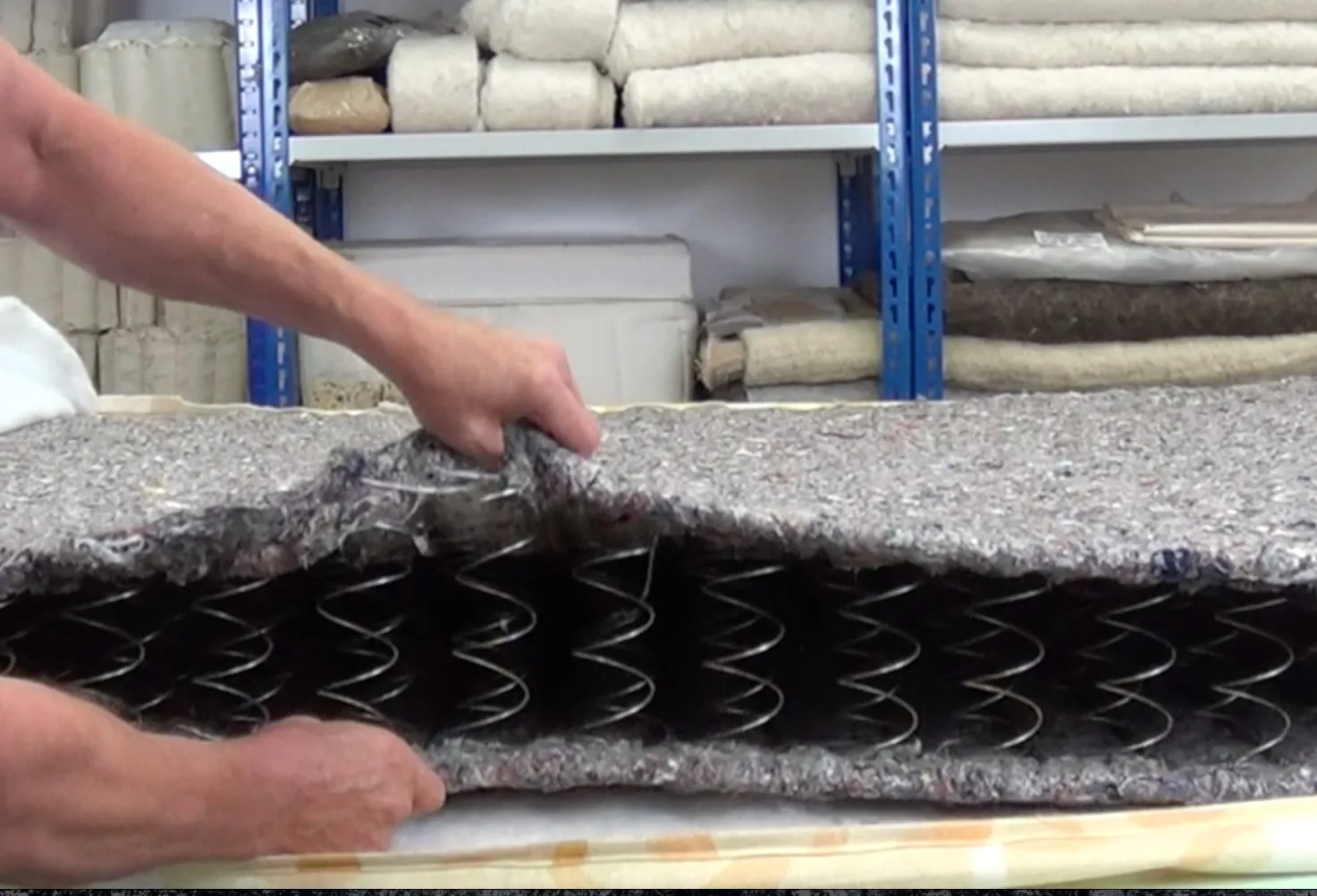
They feature an open coil spring unit which is one continuous piece of wire formed in the shape of a single spring unit. They are quick and cheap to make but offer the most limited of support in a mattress. If you remember those bouncy beds as a child (the type that shook and wobbled whenever you moved on it) then this is essentially how a cage sprung mattress works. We have written extensively about avoiding these spring units were possible with a lot more detail here.
Open Coil Price Point: Most open coil, cage sprung or Bonnel spring mattresses of this type are between £99-£300. If you’re paying more than this you should be choosing a different mattress type.
Benefits of an Open Coil Bed:
- They are very cheap to make and buy
- Lightweight – you can lift them single-handedly
- One size fits all
Drawbacks of an Open Coil Bed:
- Weak support
- Bouncy with high transference throughout the bed as you move
- Very thin upholstery means you’ll more than likely feel the springs
- No tailoring for your bodyweight or sleeping preference
Open Coil Lifespan: 2-3 years before upholstery is completely compressed.
2. Memory Foam Mattresses / Mattresses in a box
The next type of mattress are the Memory foam and ‘mattresses in a box’ types. These are entry to mid-price point mattresses, around £300-£600, that are designed to use layers of synthetic foams to create a one-sided mattress. Memory foam- believe it or not- has been around for over 25 years now and is a material that you either love or hate. Memory foam works by moulding to your body slowly when in bed. It has an open-cell foam formula which traps heat and in turn, starts to soften. Tempur is probably the most famous of all the memory foam style mattresses.
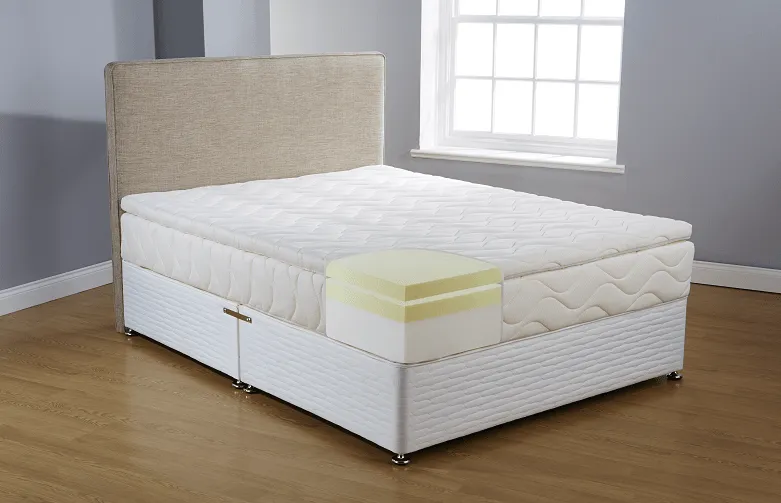
Memory foam comes in a number of densities, firmness and hardness ratings which allows you to work out whether it is at the firmer or softer end of the mattress feel. Sadly most retailers won’t give you this information any more so you’re left guessing. Have a look at the type of detail you should expect to see from retailers, if they tell you that is!
| Foam Grade | Density Min KG/M3 | Density Max KG/M3 | Hardness Min (n) | Hardness Max (n) |
|---|---|---|---|---|
| Vasco 40kg | 38 | 42 | 40 | 60 |
| Vasco 60kg | 58 | 62 | 70 | 100 |
| Laygel 60kg | 57 | 63 | 100 | 150 |
| Coolblue 70kg | 65 | 70 | 70 | 100 |
| Reflex 300 | 30 | 32 | 100 | 130 |
| Reflex 300F | 30 | 32 | 130 | 160 |
It’s great for people who are cold sleepers and like to be held in one position during the night. The ‘mattress in a box’ companies like Eve, Simba, Casper, Emma etc have also capitalised on the ease of delivery as these mattresses can be boxed and rolled, unlike pocket spring models. Making these mattresses really convenient. However, you probably want to read about the drawbacks of rolling a mattress and the damage it can do here.
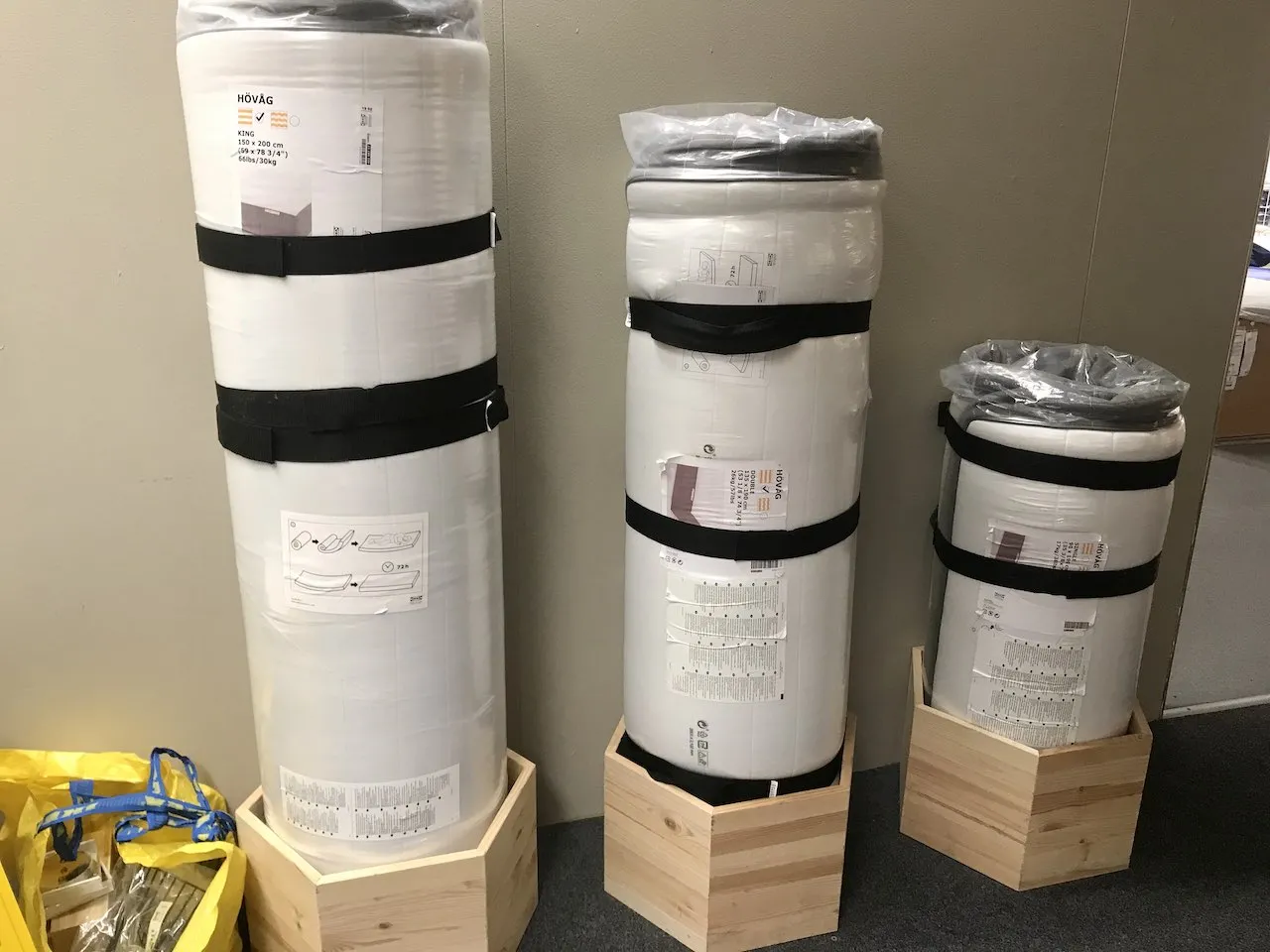
Memory Foam Price Point: You should look to be spending between £300-£600 on a memory foam mattress anything more than this and you should be looking at either Natural Latex or a Pocket Sprung model, both of which are two-sided and will last far longer.
Benefits of a Memory Foam Bed:
- They hold you in one position during the night good for deep sleepers
- Pressure relief as they absorb joints easily like elbows and hips
- Low transference and isolation between sleepers
- Can be boxed and rolled for convenient delivery
Drawbacks of a Memory Foam Bed
- Weak support for heavier sleepers
- Heat retentive so warmer sleepers need to avoid
- The least breathable of all upholstery types
- Chemically made synthetic foams have issues with off-gassing
- One-sided so will show wear far quicker than a two-sided mattress
Memory Foam Mattress Lifespan: 3-5 Years before the foam may start to sag or show permanent indentation. Usually due to the fact that they are all one-sided and the constant heat degrades the foam pretty quickly. To extend the life always use a separate memory foam topper which can be easily replaced.
3. Hybrid Foam Mattresses
Hybrid mattresses use a mix of newer upholstery styles and have been created as a result of the issues/complaints of memory foam and retail from around £400-£700. A hybrid mattress may feature a cooler foam such as Coolblue, Laygel or Igel to help address the heat issue with other memory foams. They may also include pocket springs systems such as FEPS (Foam encapsulated spring units), pocket spring systems or castellated (cut into ridges, shapes or matrix patterns) foams.
They aim to bring you the best of both Pocket Springs and the more contemporary foam ‘pressure relief’ beds. Again we would recommend that you check how you’re going to address the one-sided niggle with these models as they usually can’t be turned. Adding a separate topper can help extend the lifespan of these models.
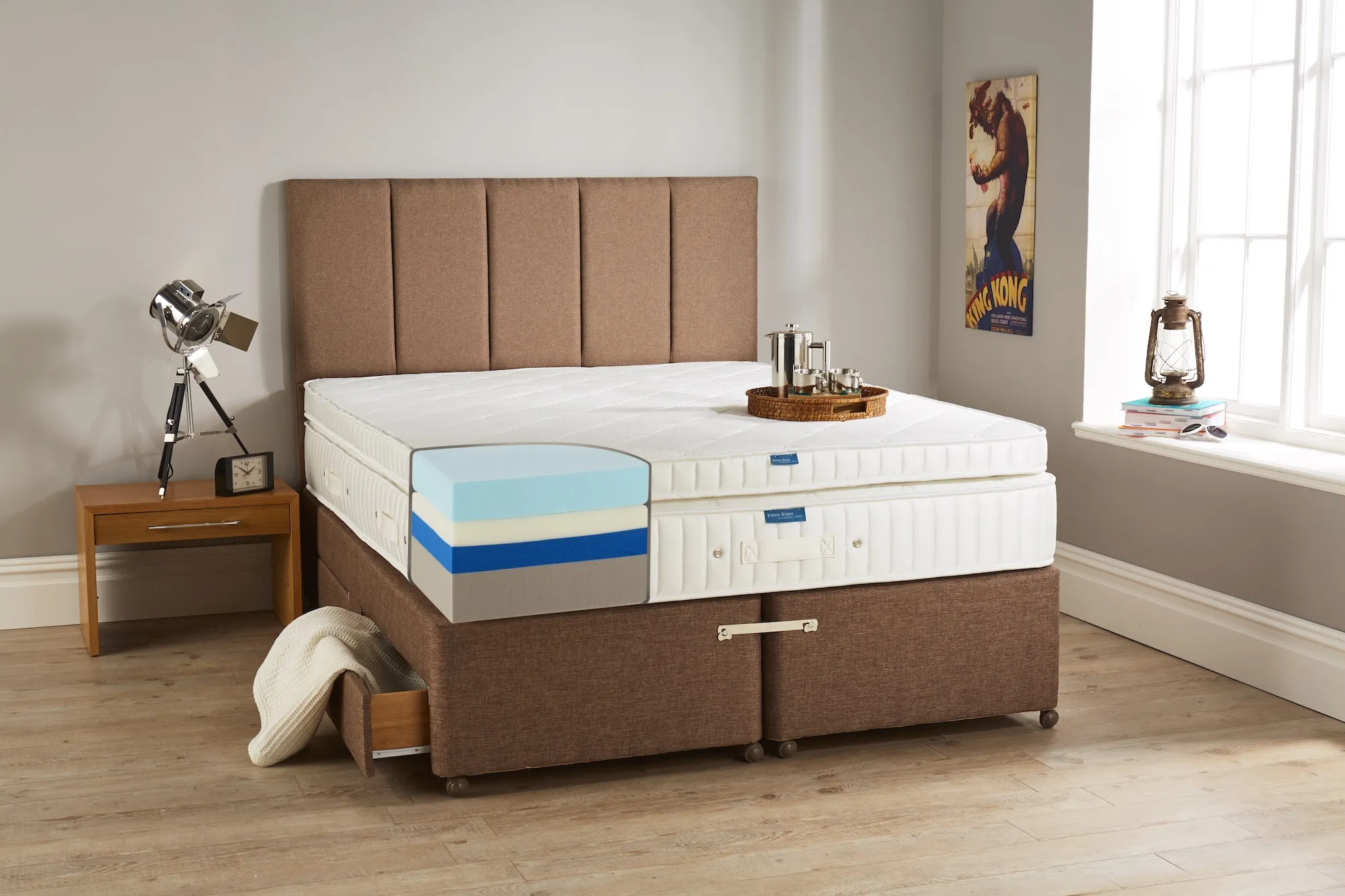
Hybrid Foam Price Point: Similarly to memory foam, the price point for these mattresses is around £400-£700. If you’re paying more than this you should also be considering Pocket Spring and Natural Latex models for your comparison beds.
Benefits of a Hybrid Foam Bed:
- They can be highly progressive in terms of a soft sink but quick to return to their original shape
- Pressure relief for hips, shoulders and backs
- Benefits of cooler foams and spring units
- Can create deep sink mattresses
Drawbacks of a Hybrid Foam Bed:
- Still heat retentive compared to Natural Fibres
- Are nearly always one-sided meaning shorter lifespan
- The mix of very different materials can create uneven settlement over time
- Chemically made synthetic foams have issues with off-gassing
Hybrid Foam Mattress Lifespan: 5-7 Years before the foam may start to sag or show permanent indentation marks on the bed. Always use a separate foam or natural fibre topper which can be easily replaced after a few years to extend its lifespan.
4. Latex Mattresses
Latex mattresses are where you start to move away from synthetic heat retentive models and move to a more sophisticated mattress choice at a price of £1000 plus. That is if you manage to choose a 100% Natural Latex mattress. The industry around Latex mattresses is rather elusive in using synthetic ‘chemically’ created Latex foam without always making it clear.
When choosing a Latex mattress you really do need to do your homework to find as close to 100% Natural as you can. The reason for this is heat retention again with synthetic foams. The more synthetic the Latex blend the more heat it will retain, often whilst also sporting the price tag you would expect to see on a 100% Natural model too!
Natural Latex is a fantastically progressive material offering a slow sink but without any of the ‘slow to respond’ issues of Memory or Hybrid foams. Natural Latex is also far more breathable and only requires pressure rather than heat to mould. Making for a far more comfortable nights sleep.
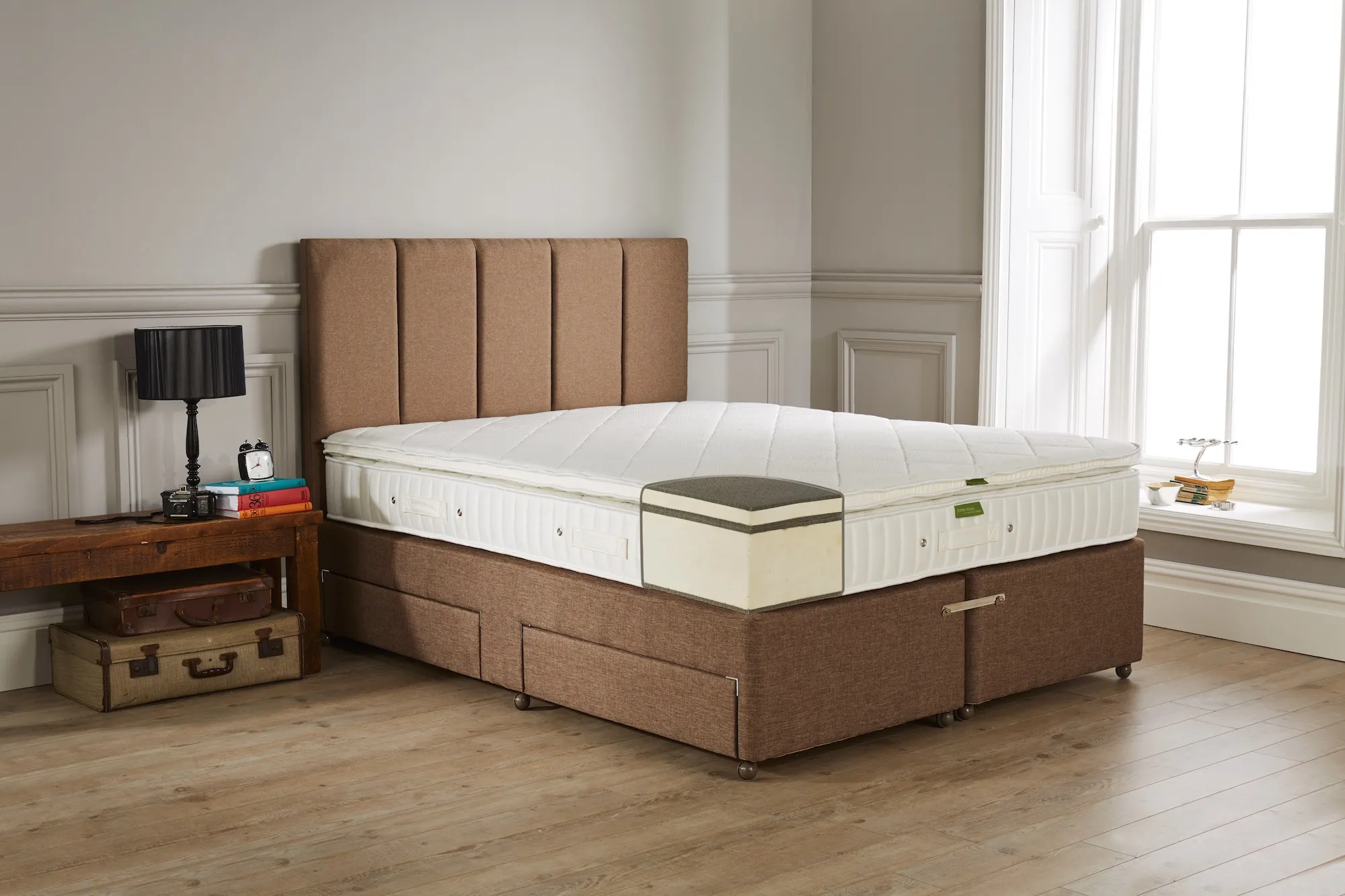
Solid core Latex mattresses are great for people with sports injuries, sensitive pressure points or those needing a deep sink to accommodate aches and pains. As they are so responsive it means that turning during the night is really easy and they have very low transference of movement between sleepers. They have an incredible lifespan with some people having them for up to 25 years if turned and looked after carefully. They are incredibly heavy though so a top tip is to make sure you choose one that’s been tape edged with side handles. Zip-off polyester and quilted covers simply can’t hold the weight of a Natural Latex mattress when being turned and will stretch and tear over time.
Price Point of Latex Mattresses: For a 100% Natural Latex mattress you’re looking at £1000-£1500. If you see a Latex mattress for under £1,000 its more than likely a synthetic latex blend which is more heat retentive and won’t last as long.
Benefits of a Latex Mattress:
- Highly responsive and progressive with a soft sink & firmer support
- Great for sports or injuries as they hold you but allow ease of movement when needed
- Long-lasting
- Isolates movement very effectively
- Can accommodate a large weight range for sleepers
Drawbacks of a Latex Mattress:
- Relatively expensive compared to other foams
- Heavy to lift, turn and rotate
- The Market is flooded with synthetic foam versions making it hard to identify true Latex models
- Still warmer than a Natural Fibre mattress
Natural Latex Foam Mattress Lifespan: 10-25 years if well looked after and turned frequently. It also worth bearing in mind that fluctuations in weight will affect mattress longevity. It’s all dependant on the consistency of your monthly mattress maintenance
5. Pocket Sprung Mattresses
Pocket Spring mattresses are probably the most widely suited of all mattress types retailing from £500-£1,000 plus. This is because they offer the most flexibility in terms of support, comfort layers and durability. Nothing has ever outperformed pocket springs in tests and online mattress reviews which is why we have saved the best until last! A Pocket Sprung mattress is made up of a spring support system which is then topped with different layers of upholstery.
Pocket springs are individually house springs that are then wrapped in either a natural calico material or polyester. We’ve written here about the detailed benefits of Pocket springs but think it is worthwhile summarising here why you should consider them.
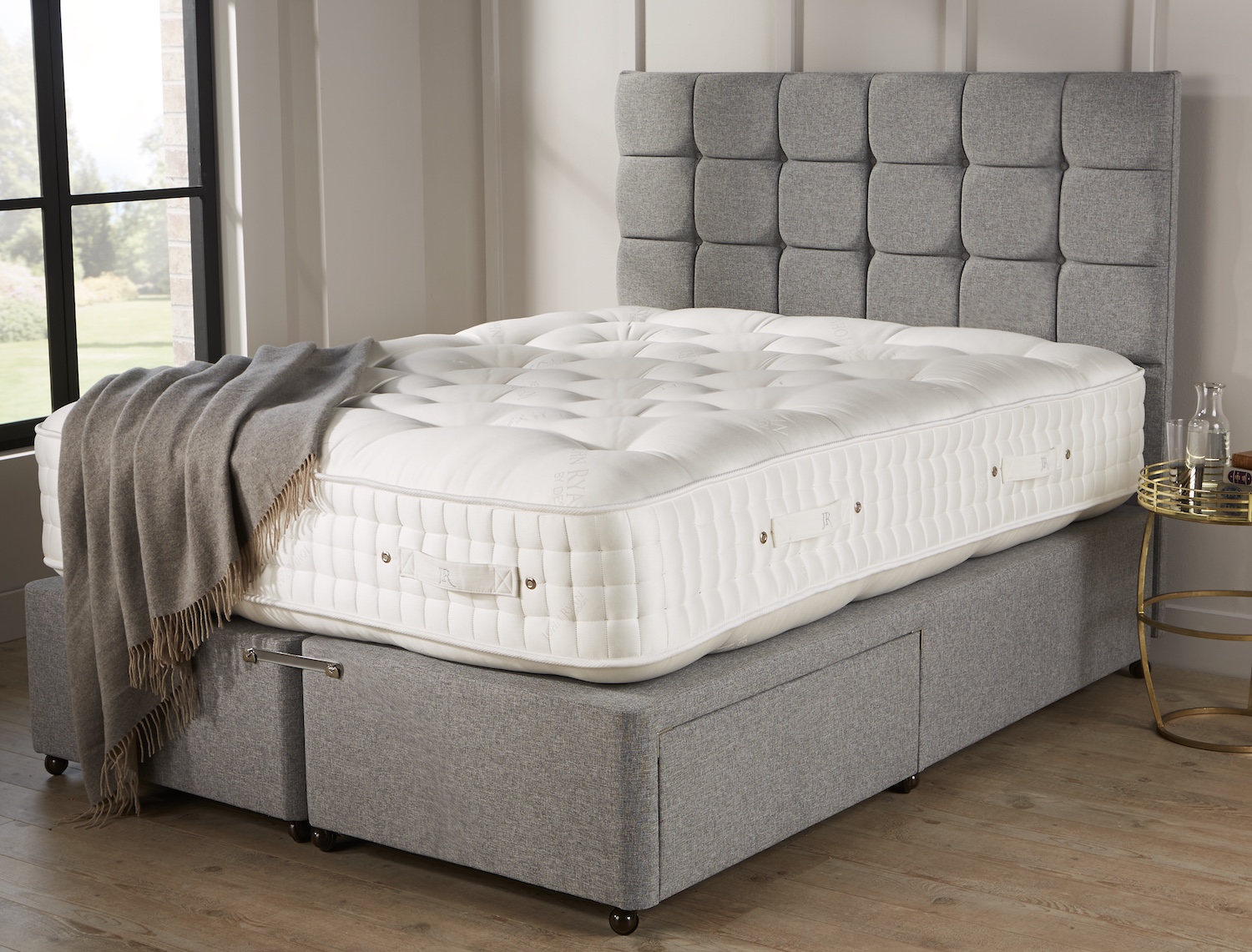
Each pocket spring can react independently of the next spring (unlike the dreadful Bonnell coil) meaning fare more selective support where you need it. Pocket springs also reduce transference and movement between sleepers significantly eliminating roll together. As they are independent you can also choose a variety of spring tensions based on the thickness of the spring wire. This is known as the spring gauge. It means that you can have a spring tension that’s been specifically designed to work with your bodyweight.
In fact, the biggest issue sleepers have is choosing a spring tension based on how they want the mattress to feel which is completely wrong. The spring tension should be chosen based on your weight. It is the upholstery layers on top that will provide the overall mattress feel.
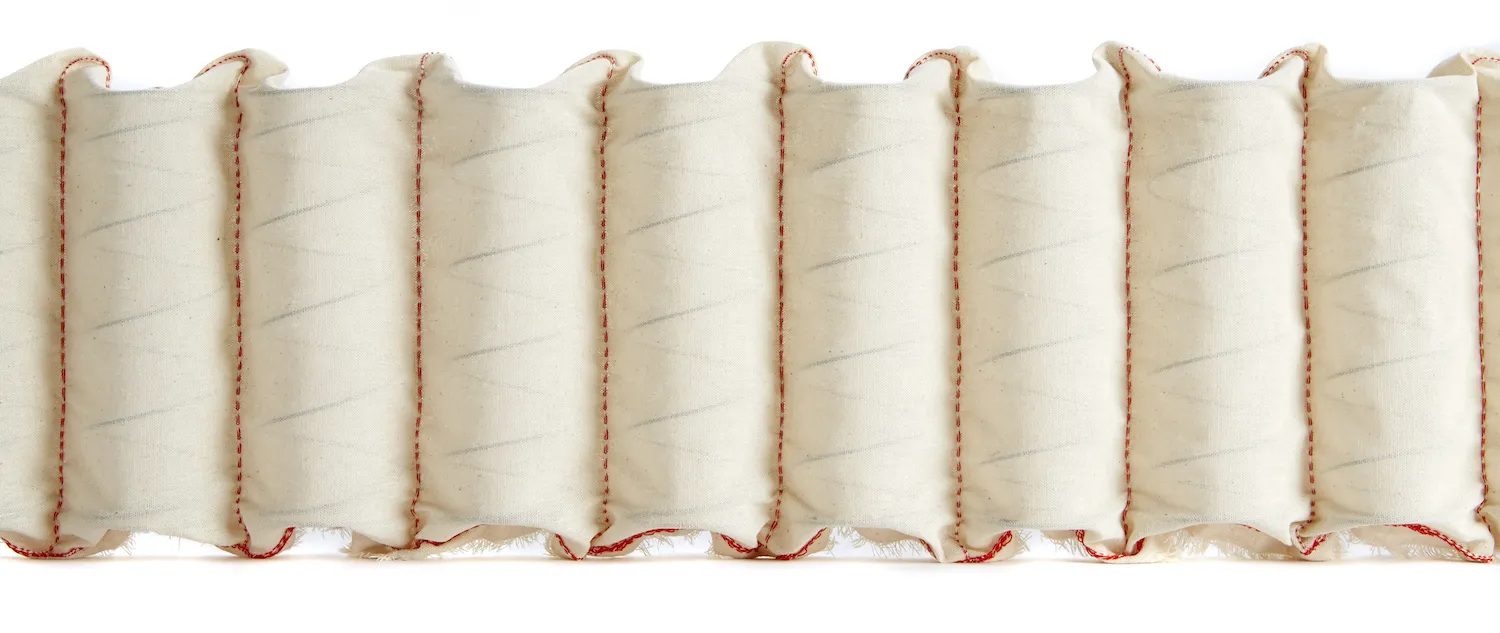
If you and your partner are different weights then you can choose a Split Tension or a Zip & Link pocket spring mattress where each half is a different tension. Meaning you can finally say goodnight to compromises and both have the correct support in bed!
Types of mattress springs
There are three main types of mattress spring you have to choose from when buying a new mattress.
- The open coil (discussed above as the worst spring)
- The Micro or HD spring (tiny usually pointless springs just to inflate the spring count)
- Pocket springs (the original and best mattress spring type)
Your budget will usually determine which mattress spring type you pick. Care must always be taken with the number of springs and not confusing with this number being a metric for mattress quality. For example, a 5000 spring mattress will only be able to contain a maximum of just over 2000 normal-sized pocket springs, so the 3000 additional springs must be HD or micro springs which often are used to bulk up the numbers.
As a mattress can only be so deep (around 32-35cm usually) so these micro springs take the place of much-needed upholstery. So you get more springs but less upholstery which therefore means less comfort during the night.
Spring tensions based on your bodyweight:
| Spring Tension | Wire diameter (Gauge) | Weight Range |
|---|---|---|
| Soft | 1.2mm | Bespoke Tension (Please Call) |
| Medium | 1.4mm | Upto 16 stone |
| Firm | 1.6mm | 16 stone plus |
| Extra Firm / Orthopaedic | 1.9mm | 20 stone plus |
Pocket springs come in two main types:
For mid-level mattresses from £500-£1000 then spunbond pocket springs are the most likely option to keep the mattress at this price point. Whereas Calico encased are on mattresses £1300+, usually reserved for 100% Natural fibre hand-made mattresses.
Calico springs are far more breathable and respond quicker than synthetic ‘stitch bond’ springs as the fabric is far softer. Cheaper mattress models will glue their pocket springs together, whereas the highest quality mattress makers will tie the springs together by hand with a needle and then side stitch them to the borders of the mattress.
Synthetic spun bond pocket springs are covered in stitch bond
Calico pocket springs are more breathable and offer more responsive support
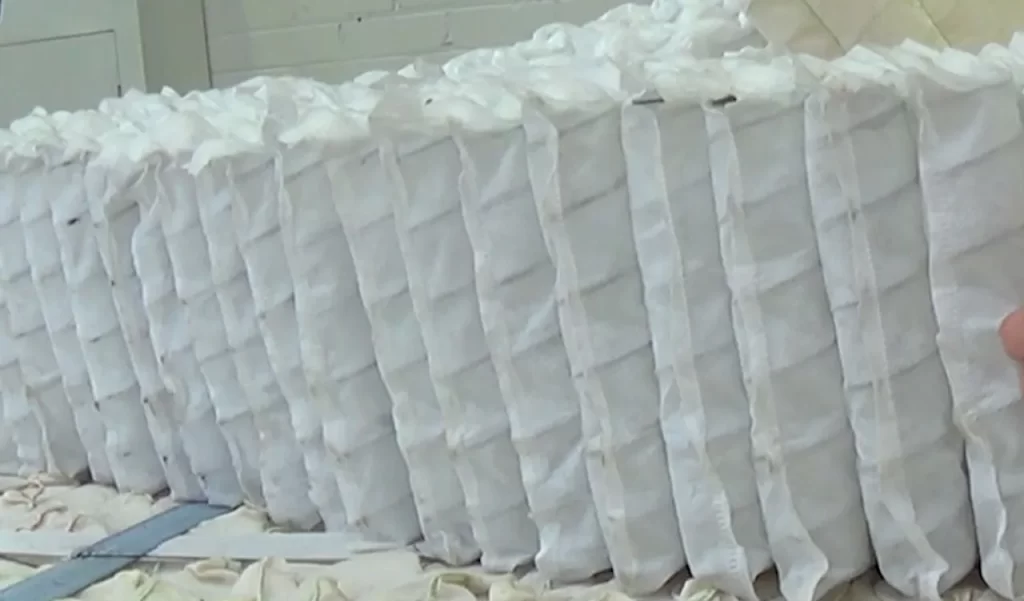
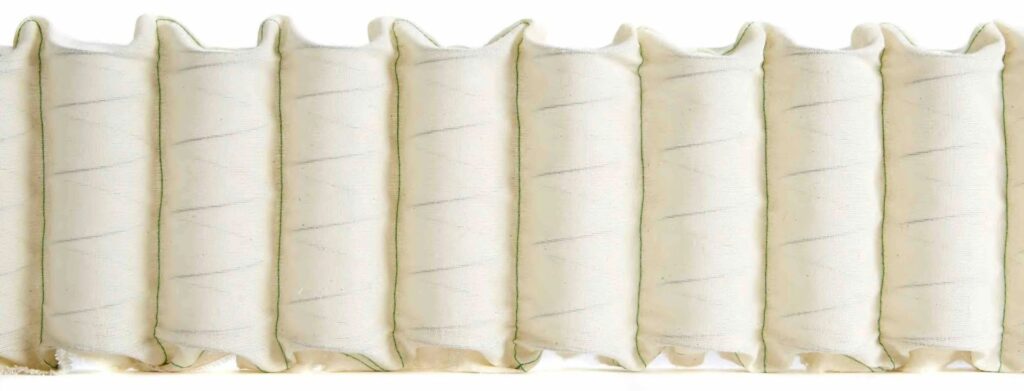
Upholstery also comes in two forms:
- Synthetic upholstery such as Polyester, White Fibre, Foam and such
- Natural Fibre Upholstery such as Wool, Alpaca, Horsetail, Bamboo, Coir etc
The most important thing for you to know when buying a mattress is to understand the upholstery that’s inside. The only way you can do this is by knowing the GSM or grams per square meter. This tells you the amount of each filling that the mattress contains. Without knowing this some retailers may only be putting in a fraction of upholstery and simply blending it with cheap synthetic polyester. You can read more on how to work out the GSM of mattress upholstery here. Pocket spring mattresses should all be two-sided – there is simply no reason to accept a one-sided model when paying £1000+. There is also plenty of other mattress detailing you need to read up on with this guide here.
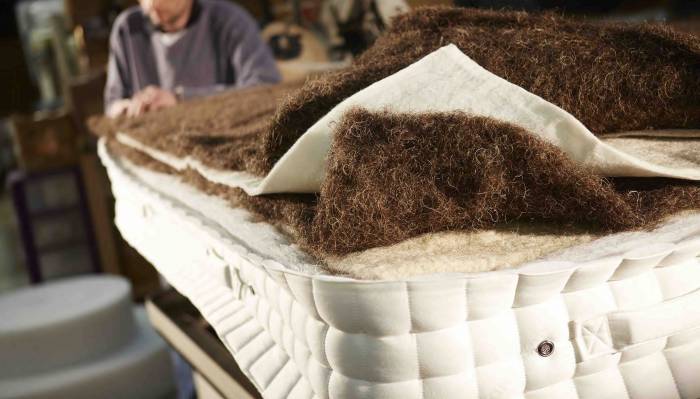
Price point of Pocket Spring mattresses: For a synthetic spun-bond spring and polyester-based fibres you’re looking at £500-£1000. For a Calico pocket spring and natural fibre model these start at around £1300 plus.
Benefits of a Pocket Sprung Mattress:
- Offers unparalleled support from independent springs
- Fully turnable
- Removes roll together
- Natural fibres provide the coolest sleep experience
- Tailored support based on your exact bodyweight
- Completely customisable
- Long-lasting
Drawbacks of a Pocket Sprung Mattress:
- Can be expensive when moving to the high end
- High GSM Models can be heavy to lift, turn and rotate
Pocket Spring Mattress Lifespan: 3-25 years depending on the upholstery and mattress construction methods used. Careful maintenance, turning and rotating will ensure the longest lifespan of your mattress.
6. Mattresses you definitely want to avoid buying
Now to make sure you don’t get stung by a few mattress types in your search for a new mattress. These models have been commented on numerous times over our 13 years in the bed industry as the absolute worst mattresses to buy. We want to make sure you don’t end up wasting money on a totally unsuitable fit for nothing mattress.
Pillowtop Mattresses
The Pillowtop mattress craze has swept the country it seems. These mattresses feature a permanently stitched ‘topper’ which is sometimes also glued to the top of the mattress. They feel lovely in showrooms as this soft top layer allows you to sink into the cloud-like top layer. However, these pillow tops not only make the mattress one-sided but also fail really quickly. This is because you can’t take them off to turn or rotate them.
Also, the fillings are usually very soft polyester, meaning they sag alarmingly quickly and as there’s no way to even this out you’re stuck with a lumpy uncomfortable mattress. Have a look at our review of the Premier Inn mattress here to see what a pillowtop mattress looks like.
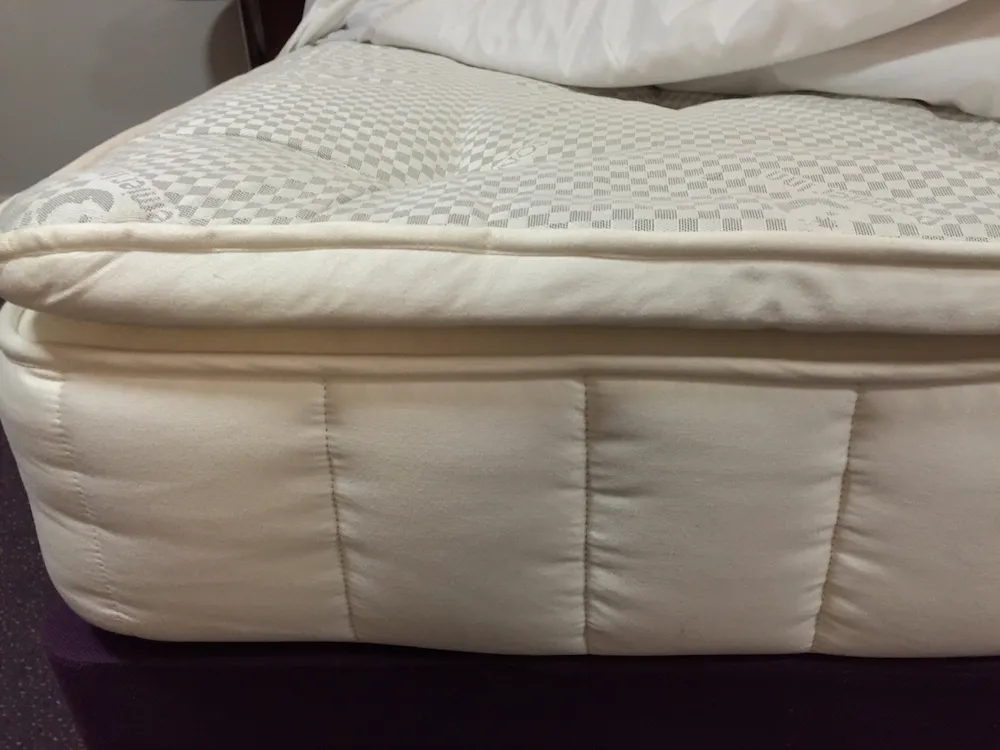
Voucher site, Shopping Channel or Online Auction Mattresses
We hear a lot from people who have used Voucher sites, discount auction sites and late-night TV infomercials to buy an absolute bargain of a bed. These are the models that are usually 60-80% off the RRP offering beds for as little as £80. You need to be careful with these deals as the RRP has been nearly always been hyperinflated. Meaning the mattress was never worth the original amount.
Most of these models give no real descriptions so you can end up with any old rubbish. These cheap mattresses are at best very low-grade foam or cage sprung models with recycled fibre that are being offloaded.
We’ve had numerous people buying super cheap mattresses of Ebay that get sent a completely different model by the seller. When they try and return it the seller has disappeared. If it sounds too good to be true it usually is. So always sleep on it before making that decision. If you get stuck give us a call and we can advise on the specification of such mattresses.

Bed & mattress types explained for bases
Lastly, we need to discuss what type of base your mattress is going onto. All bed bases are the same, right? Well, as confusing as the mattress world, the world of bed bases can be just as murky. Let’s take a look at what a mattress base is and its features.
A mattress base, also known as a foundation or bed base, is a support system that is designed to provide a stable and sturdy base for a mattress. It is typically made up of a wooden or metal frame that is covered with fabric – unless slatted, and it sits directly underneath the mattress.

The main purpose of a mattress base is to provide support and stability for the mattress, which can help to increase its lifespan and prevent sagging. It also helps to distribute weight evenly across the mattress, which can improve overall comfort and reduce pressure points while sleeping.
Additionally, a mattress base can also help to absorb shock and reduce noise caused by movement during sleep.
There are several different types of mattress bases available, in ascending order of quality they are:
- Slatted bases
- Box springs
- Platform beds
- Adjustable bases
- Bed frames
- Ottoman bases
- Divan bases
- Sprung edge bases
Each bed base type has unique features and benefits, and the best option for you will depend on your individual needs and preferences.
The key part when choosing the best mattress type for your bed base is to ensure the base is sturdy enough to take the weight and, if possible, doesn’t have slats with gaps bigger than 2 inches. If it does it’s advisable to board over these slats to stop the mattress from becoming damaged when it’s forced through the gaps as you sleep.
Summary
It can be really tricky knowing where to start when buying a new mattress. By understanding the various mattress types it should better arm you with what to expect when mattress shopping. If you start your mattress search knowing how much to spend and what to expect you’re less likely to be duped by sales tactics or pushy salespeople.
One key thing to take away is to always ask what’s exactly inside the mattress you’re looking at whether that’s in a shop or online. If a retailer can’t tell you then walk away. You should always be able to find out what’s inside any quality mattress. That is why we disclose all of the GSM’s, Spring types and Mattress Details to help you compare mattresses.
If you need further help in shortlisting suitable new mattresses give our small expert team a call for free advice on 0161 437 4419.

Dreaming of the perfect nights sleep?

Ask us a question
There are over 6000 questions and answers submitted by you on all questions about mattresses and bed problems. Enter a keyword such as Vi Spring, John Lewis beds, bad back or Memory Foam and see if your question has already been answered.
If you can’t find an answer in knowledge hub, ask a new question. We aim to respond to all questions within one working day.
Newsletter
Enter your email to join our newsletter. We’ll send you occasional news and mattress expertise.
